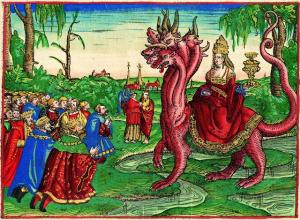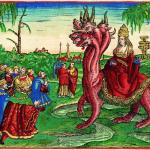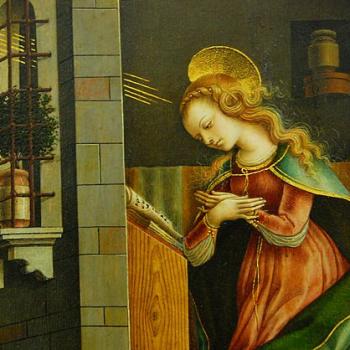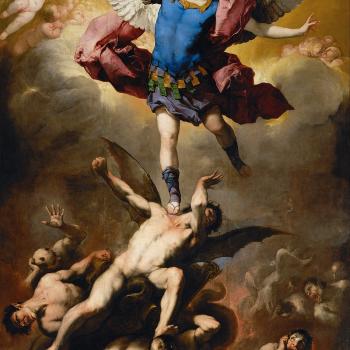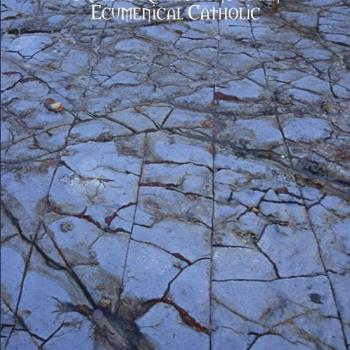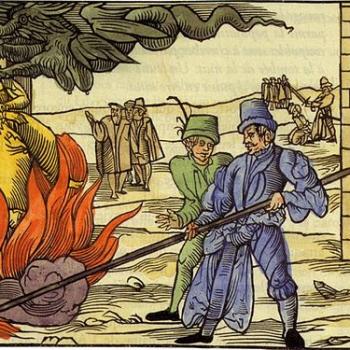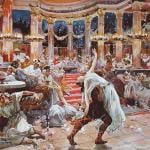Visible Church; Apostolic Succession; Protestant “Dogmatism”; Ever-Changing Rome?; Vatican II “Conciliarism”?; Doctrinal Development; Mary’s Assumption in Catholic Thought Prior to 1950
The late Steve Hays (1959-2020) was a Calvinist (and anti-Catholic) apologist, who was very active on his blog, called Triablogue (now continued by Jason Engwer). His 695-page self-published book, Catholicism — a collection of articles from his site — has graciously been made available for free. On 9 September 2006, Hays was quite — almost extraordinarily — charitable towards me. He wrote then:
I don’t think I’ve ever accused him of being a traitor or apostate or infidel. . . . I have nothing to say, one way or the other, regarding his state of grace. But his sincerity is unquestionable. I also don’t dislike him. . . . I don’t think there’s anything malicious about Armstrong—unlike some people who come to mind. In addition, I don’t think I’ve ever said he was unintelligent. For the record, it’s obvious that Armstrong has a quick, nimble mind.
Two-and-a-half years later, starting in April 2009 and up through December 2011 (in the following quotations) his opinion radically changed, and he claimed that I have “an evil character,” am “actually evil,” “ego-maniac, narcissist,” “idolater,” “self-idolater,” “hack who pretends to be a professional apologist,” given to “chicanery,” one who doesn’t “do any real research,” “a stalwart enemy of the faith . . . no better than [the atheists] Richard Dawkins or Christopher Hitchens,” with an intent to “destroy faith in God’s word,” “schizophrenic,” “emotionally unhinged,” one who “doesn’t trust in the merit of Christ alone for salvation,” “has no peace of mind,” “a bipolar solipsist,” “split-personality,” and a “bad” man. He wasn’t one to mince words! See more gory details.
I feel no need whatsoever to reciprocate these silly and sinful insults. I just wanted the record to be known. I’ve always maintained that Hays was a very intelligent man, but habitually a sophist in methodology; sincere and well-meaning, but tragically and systematically wrong and misguided regarding Catholicism. That’s what I’m addressing, not the state of his heart and soul (let alone his eternal destiny). It’s a theological discussion. This is one of many planned critiques of his book (see my reasons why I decided to do this). Rather than list them all here, interested readers are directed to the “Steve Hays” section of my Anti-Catholicism web page, where they will all be listed. My Bible citations are from the RSV. Steve’s words will be in blue.
*****
[Chapter 4: Catholic Apologetics]
Catholicism of the mind
They don’t convert to Catholicism based on evidence for Catholicism. Rather, they convert to Catholicism despite evidence to the contrary. [p. 166]
This is self-refuting. I just wanted my readers to see it.
As the world slept
This dovetails with the claim of Catholic apologists that Jesus founded a visible church (i.e. unified hierarchical organization). It has a visible head (the pope). But compare that to Christ’s kingdom parable about the seed growing at night. In that respect, God’s kingdom is invisible. It grows at night while the farmer sleeps. It grows at night while the world sleeps. . . . In that respect, the church represents a silent revolution. It grows and spreads under cover of darkness. [p. 167]
That doesn’t describe the following passage about a visible Church:
Matthew 5:14-16 You are the light of the world. A city set on a hill cannot be hid. [15] Nor do men light a lamp and put it under a bushel, but on a stand, and it gives light to all in the house. [16] Let your light so shine before men, that they may see your good works and give glory to your Father who is in heaven. (cf. Mk 4:21; Lk 11:33]
In the Synoptics, the church and the kingdom of God are closely related categories. [p. 167]
Here Hays confirms an earlier argument of mine, from Reply #12. He had written,
Where do we find “the church” in the Gospel of Mark? Mark’s Gospel never mentions “the church”. Where do we find “the church” in the Gospel of Luke? Luke’s Gospel never mentions “the church”. Where do we find “the church” in the Gospel of John? John’s Gospel never mentions “the church”. The only Gospel that even mentions “the church” is Matthew’s Gospel. And it mentions “the church” just two times. That’s it! [p. 99]
My answer was that “kingdom of God / heaven” was massively found in the Gospels (84 times, in fact) and that it was basically a synonym for “church.” Thus, Hays contradicts himself. On page 99 of his book he can barely find “the church” in the Gospels. Now on page 167, he can. We all live and learn, I reckon. At least he was half-right in his book.
Prooftexting apostolic succession
[Choosing Matthias to replace Judas was] maintaining the symbolism of the Twelve after Judas defected. . . . there can’t be more or less than Twelve at a time. . . . The Twelve is a closed number. Judas was replaced to maintain the symbolism. By definition, you can’t extrapolate from a closed number (the Twelve) to an indefinite number beyond twelve at a time. The Twelve constitute a self-contained unit. There can only be
changes within that unit. [p. 168]
The twelve disciples are also called “apostles” (Mt 10:2; Rev 21:14). There are more apostles than twelve (e.g., St. Paul). So much for this argument. But there’s more:
Luke 10:1 the Lord appointed seventy others, and sent them on ahead of him, two by two, into every town and place where he himself was about to come.
The classic Protestant commentators acknowledge these as further “disciples” and they seem to be called “disciples” in Luke 10:23 too. Benson Commentary states that “He . . . sent out seventy of his disciples” and “It is remarkable that our Lord assigns the same reason for the mission of the seventy which he had assigned for the mission of the twelve disciples.” Ellicott’s Commentary for English Readers refers to “the seventy disciples.” So does Matthew Henry. and Jamieson-Fausset-Brown Bible Commentary. Gill’s Exposition of the Entire Bible states that “besides the twelve, whom he chose and called out, from among the multitude of the disciples, and ordained them apostles, he selected and ordained seventy others.” Meyer’s NT Commentary adds:
That Jesus in general had around Him a larger circle of constant disciples, besides the Twelve, from whom He could appoint seventy for a special commission, is in itself, and from the evidence of such passages as Acts 1:15; Acts 1:21, 1 Corinthians 15:6, as well as John 6:60, not to be doubted.
My argument, then, is that neither “disciples” nor “apostles” are confined in the Bible to twelve people alone (though there is definitely a strong sense of “the [original] twelve”). Acts 6:1 states that “the disciples were increasing in number.” Hays’ argument that the original twelve always had to be twelve falls flat as a result. We even see the seventy disciples doing the exact same sorts of evangelistic things that the original twelve did. Matthias is an example of true apostolic succession in the Bible. Since Protestants reject apostolic succession, Hays had to find some sort of way to discount that, and this desperate answer is what he came up with.
You then play a shell game by switching from that to apostles appointing elders, as if that flows out of the appointment of Mathias. But that’s categorically different. [p. 168]
It is a different category, but this is sanctioned in the passage itself, since Luke cites Psalms 108:8 in Acts 1:20: “His office let another take.” The Greek for “office” is episkopé (Strong’s word #1984): the word for “bishop” and the root of “episcopal.” Thayer’s Greek Concordance writes about its use in this passage:
c. after the analogy of the Hebrew פְּקֻדָּה (Numbers 4:16; 1 Chronicles 24:19 (here the Sept. ἐπίσκεψις), etc.), oversight i. e. overseership, office, charge; Vulg. episcopatus: Acts 1:20, from Psalm 108:8; specifically, the office of a bishop (the overseer or presiding officer of a Christian church): 1 Timothy 3:1, and in ecclesiastical writings
In KJV, it’s translated “bishoprick” at Acts 1:20 and “bishop” at 1 Timothy 3:1. This clinches the case for apostolic succession from the Bible itself, since Judas was in effect called a bishop or elder, and this is the office that Matthias would assume, and which would be perpetual throughout Church history. The cognate episkopos (Strong’s word #1985) is defined by Strong (with obvious Protestant bias — not wanting to say the word “bishop”), as “overseer, supervisor, ruler, especially used with reference to the supervising function exercised by an elder or presbyter of a church or congregation.”
That’s still quite sufficient, however, to make the argument for apostolic succession. The word appears five times in the NT. KJV translates it as “bishop(s)” four out of five times, and “overseer” in the remaining appearance. If we consult English translations for 1 Timothy 3:2, which has episkopos, we see that bishops is used 26 times in one particular listing, while “overseer” also appears 26 times, “leader” eight times, and “elder” twice. No problem for the Catholic and larger “episcopal Church government” view. “Overseer” and “leader” are synonyms for “bishop” anyway.
Moreover, Acts 1:25 states that Matthias would “take the place in this ministry . . . from which Judas turned aside.” The word there is diakonia (Strong’s word #1248): from which deacon derives (Acts 1:17 applies the same word to Judas, too). It’s usually translated “ministry” in English translations, and the same word is applied to Christian work of non-apostles (e.g., Acts 6:4; 1 Cor 12:5: “varieties of service”; 1 Cor 16:15: “the household of Stephanas . . . have devoted themselves to the service of the saints”).
No transfer of office. To the contrary, the Twelve is, in the nature of the case, a self-enclosed numerical unit. You can’t legitimately expand from that to more than twelve at a time. [p. 168]
As I already proved, the Bible and Jesus — contrary to Pope Steve Hays III — did indeed do that (both “disciple” and “apostle” are applied to many more people than the original “twelve”). Hence, in John 6, when Jesus teaches Real Presence in the Eucharist, the “proto-Protestants” who had followed Him couldn’t handle that and left Him (“After this many of his disciples drew back and no longer went about with him” — John 6:66: an appropriate number for such apostasy!). This is immediately opposed to the twelve, since the next verse states, “Jesus said to the twelve, ‘Do you also wish to go away?’ ” Again, none of this refutes the biblical reasoning for apostolic succession. It’s just grasping at straws.
The fact that each of the Twelve might be classified as an apostle doesn’t imply that all apostles are disciples in the exclusive sense of the Twelve. [p. 169]
We agree, but it still doesn’t rebut our argument for apostolic succession, which I made above, and which Hays (as so often) seems blissfully unaware of.
But Catholics don’t think there’s a permanent apostolic office with successive incumbents. They don’t think apostolic succession means one apostle succeeding another apostle. Rather, they think bishops in union with the pope are the true successors to the Apostolate. . . . apostolic succession involves a shift from apostles to bishops. Different principle. Replacing one apostle with another apostle isn’t any kind of precedent for replacing an apostle with a bishop. [p. 170]
Precisely as I showed through biblical Greek words (transfer from apostles to bishops and deacons and elders . . . There was only one Apostle Paul, too, yet he appears to pass on his office in some sense to Timothy:
2 Timothy 1:6, 11, 13-14 Hence I remind you to rekindle the gift of God that is within you through the laying on of my hands; . . . [11] For this gospel I was appointed a preacher and apostle and teacher, . . . [13] Follow the pattern of the sound words which you have heard from me, in the faith and love which are in Christ Jesus; [14] guard the truth that has been entrusted to you by the Holy Spirit who dwells within us.
2 Timothy 2:2 and what you have heard from me before many witnesses entrust to faithful men who will be able to teach others also.
2 Timothy 4:1-2 I charge you in the presence of God and of Christ Jesus who is to judge the living and the dead, and by his appearing and his kingdom: [2] preach the word, be urgent in season and out of season, convince, rebuke, and exhort, be unfailing in patience and in teaching.
Hays was obviously unfamiliar with the entire classical argument from Matthias for apostolic succession. He never delved into the relevant Greek words. I did. My argument was thoroughly, deeply biblical; his was only biblical in a superficial, “surfacey” sense and a mere knee-jerk false tradition of men. We see this again and again in anti-Catholic polemics. They pick-and-choose. We go deep and incorporate all relevant cross-references. I have many more articles on this topic (with additional arguments):
A difference, to be a difference, must make a difference
Catholicism takes the position that in addition to Biblical revelation, I’m duty-bound to believe Catholic dogmas. It is sinful to disbelieve them. [p. 171]
Is this unique to Catholicism? Nope. We also see it in the infamous Calvinist Synod of Dort in the Netherlands in 1618–1619, which required all Calvinists to believe in the five tents known by the acronym TULIP. The thirteen Arminian ministers (the “Remonstrants”) refused, and were ordered to stop preaching, which they also refused to do. On July 5, 1619 they were sentenced as “disturbers of the public peace” and ordered to leave the country. Wikipedia describes what then occurred:
There followed the political condemnation of the statesman Johan van Oldenbarnevelt who had been the protector of the Remonstrants. For the crime of general perturbation in the state of the nation, both in Church and State (treason), he was beheaded on 13 May 1619, only four days after the final meeting of the Synod. As consequence of the Arminian defeat, the jurist Hugo Grotius was given a life sentence in prison; but he escaped with the help of his wife. Both Van Oldenbarnevelt and Grotius had in fact been imprisoned since 29 August 1618.
These Dutch Calvinists played the game that they learned from the Lutherans, Calvin, and the Anglicans: simply redefine religious differences as treason and kill anyone who proclaims them. Only Catholics believe(d) in dogmas, and only they persecuted outsiders? Think again. Protestantism has a massive history of persecution and intolerance. Lutherans and Calvinists alike murdered the Anabaptists, folks who — like Steve Hays — believed in adult “believer’s” baptism. In that utterly intolerant Protestant world with the beloved State-Churches, Hays and his comrade, fellow Reformed Baptist James White could very well have been executed (usually by drowning, in mockery of adult baptism). I, on the other hand, as a Catholic, would merely be exiled.
Indeed, it may be a mortal sin. [p. 171]
Well, I guess old poor Johan van Oldenbarnevelt must have committed a mortal sin, then, since he lost his head over the crime of not believing in doctrinaire Calvinism. Many hundreds of Catholics were murdered in England under Butcher Henry VIII (430 martyrs) and Evil Queen Bess (312 victims) — often by being hanged, drawn, and quartered: disemboweled, hearts cut out, etc. –, for the “treasonous” view of not accepting the saintly inveterate adulterer and murderer Henry VIII — instead of wicked, evil popes — as the Supreme Head of the Christian Church.
The church of Rome is like Neurath’s ship, which undergoes constant remodeling after it leaves dry dock. You can no longer say what Catholicism is or means because that’s subject to some unforeseeable future revision or reinterpretation. What is ever truly definitive? What is ever truly authoritative? [p. 174]
As I’ve reiterated again and again, Catholics know exactly what we believe. We’re far more precise and definite than any Protestant denomination. Hays never takes one Catholic doctrine and proves beyond doubt (from our sources) that it has fundamentally changed. It’s all empty rhetoric and baseless hyper-polemics. On the one hand we are blasted and derided because we believe in dogmas that must be adhered to. Then Hays, without missing a beat, will turn around and claim that no one knows what Catholics believe (“What is ever truly definitive?”), or will have to believe in the future. Which is it? He couldn’t comprehend development of doctrine to save his life. And because of that gross deficiency in his understanding, he was doomed to never grasp the nature of historical theology and its consistent progression over time.
Hays does vainly attempt, however (pp. 174-175), to assert that “no salvation outside the Church” has changed and that the Church supposedly taught in the past that every non-Catholic was inevitably, irrevocably damned to hell. I’ve already addressed that, and so need not do it again.
What’s the official ecclesiology in Vatican II? Is it the more collegial, conciliarist model that the majority of bishops voted for, or is it the more ultamontane model in the “explanatory note” of Paul VI? [p. 175]
It’s the same as it has always been: the pope as supreme head; bishops in council must ultimately agree with the pope. Unlike Hays’ usual modus operandi, I will actually cite the council. The Dogmatic Constitution on the Church (Lumen Gentium) taught that “This teaching concerning the institution, the permanence, the nature and import of the sacred primacy of the Roman Pontiff and his infallible teaching office, the sacred synod proposes anew to be firmly believed by all the faithful” (18). Next question? It also strengthened the concept of conciliar infallibility more than ever, but not with any implication that they could oppose the pope (the error of conciliarism).
Paul VI was clearly alarmed by what the bishops promulgated, so he overruled it with his explanatory note. Yet these two competing models of ecclesiology bump up against each other in the final edition. Both were codified at the same council. . . . wouldn’t we expect a divine teaching office to be able to head off that train wreck in advance, rather than letting the two trains collide, . . .? [p. 175]
They do not. If Hays was so sure they did, why in the world wouldn’t he nail it down once and for all with documentation? Instead, we get his usual bald assertion without demonstration. His research abilities are about equal to a nine-year-old writing a book report. He just didn’t get it. Poor fellow . . .
To begin with, the particular doctrine (Assumption of Mary) is a theological innovation. It was unknown before the 5C. [p. 176]
As shown, it was present (implied) in Revelation 12 and follows deductively from the logical end of Mary’s Immaculate Conception or sinlessness. The latter is explicitly stated in Luke 1:28, closely scrutinized. After the biblical period, it took a while to develop fully, as is the case with many doctrines (where Catholics and Protestants agree), including trinitarianism and the Two Natures of Christ.
In addition, the theory of development is a theological innovation. It represents a fundamental break with how the church of Rome used to define sacred tradition. [p. 176]
Sheer nonsense (I’m tempted to use a much stronger description!). It was very explicit in St. Vincent of Lerins in the 5th century and almost as much in St. Augustine. See my article, Development of Doctrine: Patristic & Historical Development (Featuring Much Documentation from St. Augustine, St. Vincent of Lerins, St. Thomas Aquinas, Vatican I, Popes Pius IX, Pius X, Etc.) [3-19-02]. This is exactly what Hays desperately needed to learn and understand, but alas, he never did.
Notice that the Assumption of Mary was promulgated despite unanimous opposition of Catholic theological faculties at the time. That’s not just because the doctrine itself lacks traditional pedigree, but because the justification is yet another theology innovation. [p. 176]
More poppycock. Catholic theologian Alan Schreck observed:
In the hundred years before Pope Pius’ declaration, the popes had received petitions from 113 cardinals, 250 bishops, 32,000 priests and religious brothers, 50,000 religious women, and 8 million lay people, all requesting that the Assumption be recognized officially as a Catholic teaching. Apparently, the pope discerned that the Holy Spirit was speaking through the people of God on this matter. (Catholic and Christian, Ann Arbor, Michigan: Servant Books, 1984, 180)
I don’t know how many Catholic scholars (or “Catholic” in name only) rejected the Assumption in 1950. I haven’t found anything. But then again, as usual, Steve hasn’t give us any documentation so why bother? It’s his burden to establish his claim.
***
Practical Matters: Perhaps some of my 4,300+ free online articles (the most comprehensive “one-stop” Catholic apologetics site) or fifty-one books have helped you (by God’s grace) to decide to become Catholic or to return to the Church, or better understand some doctrines and why we believe them.
Or you may believe my work is worthy to support for the purpose of apologetics and evangelism in general. If so, please seriously consider a much-needed financial contribution. I’m always in need of more funds: especially monthly support. “The laborer is worthy of his wages” (1 Tim 5:18, NKJV). 1 December 2021 was my 20th anniversary as a full-time Catholic apologist, and February 2022 marked the 25th anniversary of my blog.
PayPal donations are the easiest: just send to my email address: [email protected]. You’ll see the term “Catholic Used Book Service”, which is my old side-business. To learn about the different methods of contributing, including 100% tax deduction, etc., see my page: About Catholic Apologist Dave Armstrong / Donation Information. Thanks a million from the bottom of my heart!
***
Photo credit: The Whore of Babylon (workshop of Lucas Cranach): colorized illustration from Martin Luther’s 1534 translation of the Bible [public domain / Wikimedia Commons]
***
Summary: The late Steve Hays was a Calvinist and anti-Catholic writer and apologist. This is one of my many critiques of Hays’ “Catholicism”: a 695-page self-published volume.


